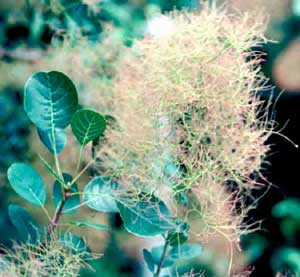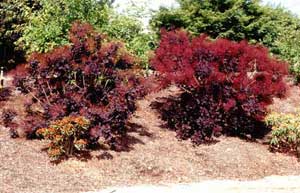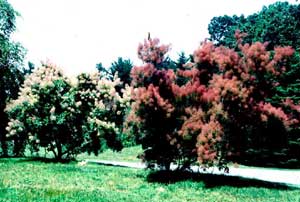Landscape Shrubs
Common Smokebush
(Cotinus coggygria)
Where there is smoke, there must be fire—and this is a hot plant for your Arkansas garden. Common smokebush or smoketree (Cotinus coggygria) has been a staple of American gardens for a long time. English literature describes this plant in use as early as the 1500s.
Starting in May, the purple foliage branches are tipped with large, smoke-like plumes of flowers. The actual flowers are very ineffective since they are extremely small and yellowish in color. What we actually enjoy as “flowers” are minute hairs along the structure of the panicle inflorescence. These small, fibrous hairs vary in color from a cream, to pale green, to pink or vivid red—depending on the cultivar. This plume of colored hairs creates a smoky look that lasts from May until fall. Look closely after June and you will notice very small seeds in the plume.
The purple or blue-green, oval-shaped leaves have an entire margin (no teeth) and rarely look disfigured. Although it is not a reliable or consistent quality, the leaves occasionally turn an impressive fire color in the fall. Most people prefer the purple foliage forms; like Japanese maples, the intensity of purple color varies widely depending on the cultivar and time of year. Two of the more popular cultivars, ‘Velvet Cloak’ and ‘Royal Purple,’ hold their color well into the summer and have a dark-purple, almost black purple foliage color. (Unfortunately, ‘Velvet Cloak’ is like a plant on bad steroids. The growth rate and leaf size is grotesque. It appears to be better suited for milder climates where the rich leaf color is enhanced by cooler summer temperatures.) ‘Daydream’ is a nice green foliage form that has rich pink hairs in the plume. In the next year or so you should see a sulfur yellow foliage cultivar on the market called Golden SpiritTM.
The native American smoketree, Cotinus obovatus, has an attractive, clean, blue-green color. Leaves are typically larger than C. coggygria and obovate in shape. While the “plume of smoke” is not as dramatic as that on common smokebush, the fall orange-red color is to die for. American smoketree is typically a multi-stemmed, upright oval shaped, small tree (30’ tall x 12’ wide). The bark has a distinctive, almost shingle-like appearance.
Another Cotinus, called C. x ‘Grace,’ is a cross between C. coggygria ‘Velvet Cloak’ and our native C. obovatus. The cross was designed to bring some of the purple foliage from ‘Velvet Cloak’ into the hybrid and to improve the fall color.
The smokebush is considered a large multi-stemmed shrub (10’ tall by 10’ wide) or a small tree. It will do best in full sun or partial shade. Purple foliage forms will have poor color if planted in too much shade. This is an easy keeper plant. In general, it is fairly tolerant of soils and will tolerate hot, dry sites better than many other plants. It will certainly perform better in a moist, rich soil and I encourage renewal pruning of larger stems to keep vigorous shoots active. Disease or insect problems are rare. Any way you slice it, a smokebush would make a wonderful specimen plant in most gardens.
- Common Name: smokebush
- Varieties to look for: ‘Velvet Cloak,’ ‘Royal Purple’
- Flower Color: pink “flowers”
- Blooming period: May until fall
- Type: deciduous shrub
- Size: large; 10’ tall x 10’ wide
- Exposure: full sun
- Soil: tolerant
- Watering: adaptable but moist best
- When to prune: early spring
- Suggested use: specimen, shrub border
Leaf and hair structures

Form in deep purple color


Form represented in two colors
